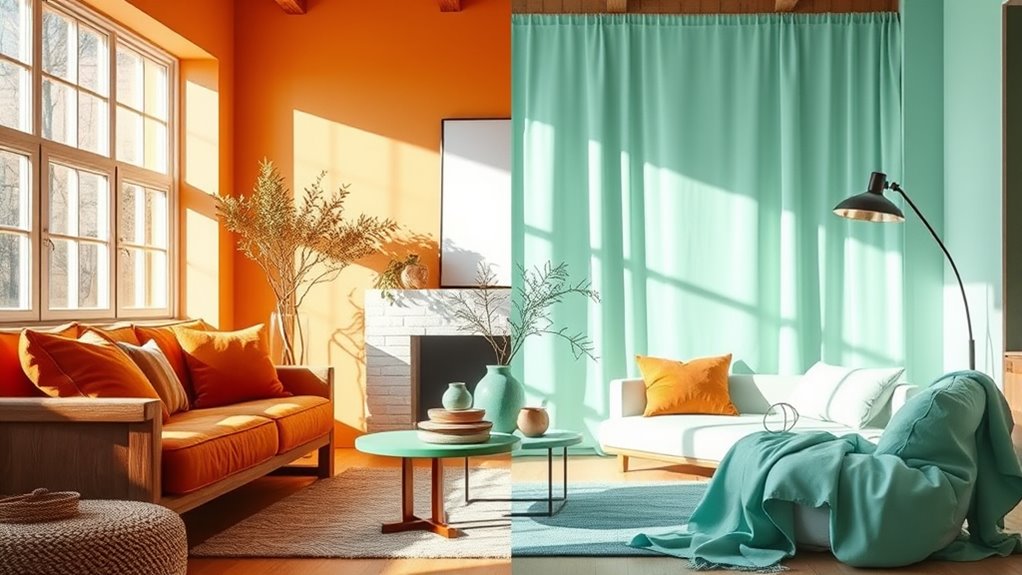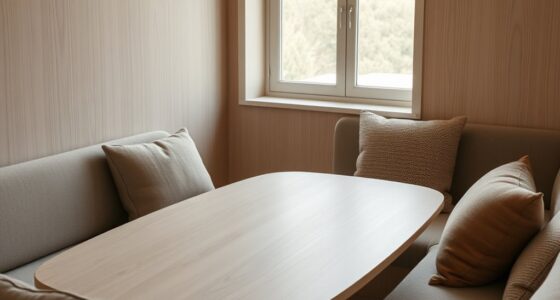Warm colors like red, orange, and yellow evoke strong emotions such as passion, energy, and coziness, making your space feel inviting and lively. Cool tones like blue and green promote calmness, relaxation, and stress reduction, creating serene environments. Both palettes influence mood and behavior, so choosing the right hues depends on your desired effect and space use. To discover how to balance these tones effectively and enhance your environment, keep exploring these color psychology insights.
Key Takeaways
- Warm tones (reds, yellows, oranges) evoke energy, passion, and coziness, making spaces feel inviting and lively.
- Cool tones (blues, greens, lavenders) promote calmness, relaxation, and reduce stress, ideal for tranquil environments.
- Combining warm and cool colors can create balanced spaces that energize and soothe simultaneously.
- Cultural significance influences how specific hues are perceived, affecting emotional responses in decor.
- Strategic color choices impact mood, ambiance, and functionality, enhancing the psychological effects of interior design.
The Emotional Impact of Warm Colors
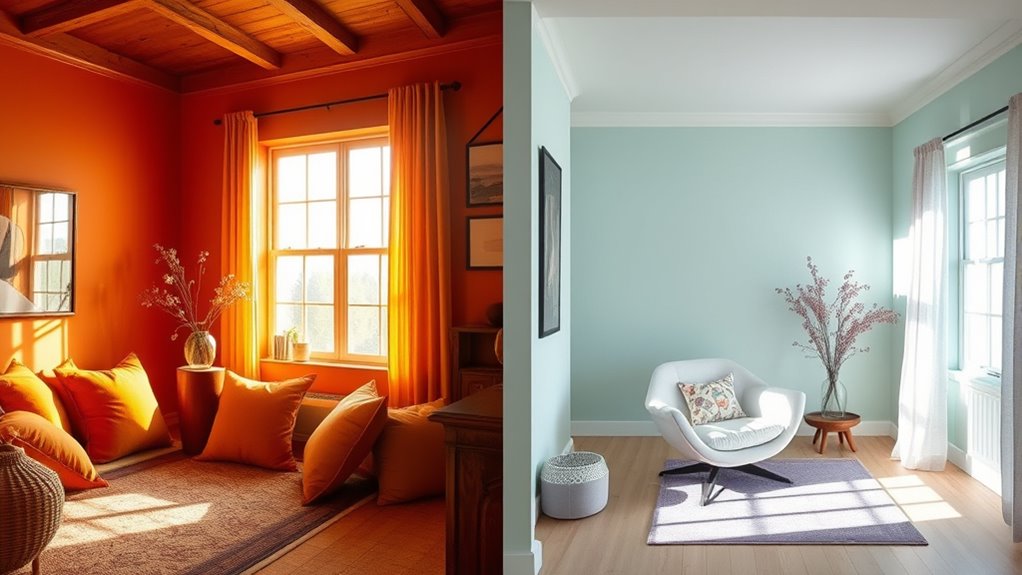
Warm colors like red, orange, and yellow are known for their ability to evoke strong emotional responses. Their color symbolism often connects to feelings of passion, energy, and warmth. In many cultures, red symbolizes love, luck, or danger, while yellow is associated with happiness and optimism. Orange combines these qualities, representing enthusiasm and creativity. Your use of warm tones can influence mood instantly, making spaces feel lively or cozy. Cultural associations deepen these effects—red in China signifies prosperity, whereas in Western cultures, it’s linked to love and excitement. By understanding these connections, you can intentionally choose warm colors to foster specific emotions and atmospheres in your environment. Recognizing the cultural significance of colors helps you select hues that resonate meaningfully with your personal or cultural context. Remember, the cultural context shapes how these colors impact you emotionally.
The Calming Effect of Cool Tones
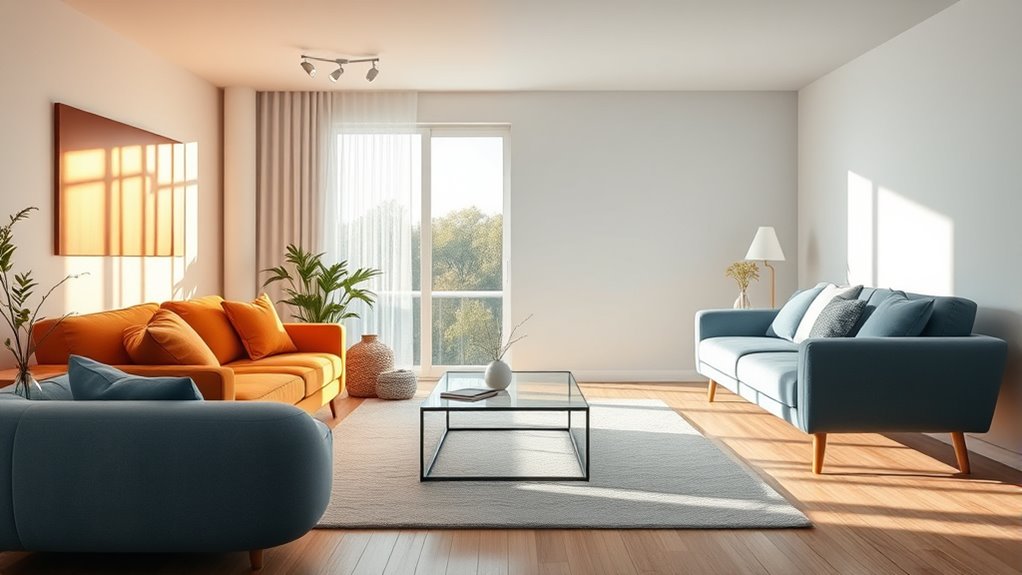
Cool tones help you create a tranquil atmosphere that feels peaceful and relaxing. When you incorporate shades like blue or green, you can easily reduce stress and promote calmness. These colors make your space more soothing, encouraging you to unwind and stay centered. Engaging with sound healing science through calming music or frequencies can further enhance this soothing environment.
Tranquil Atmosphere Creation
Since cool tones are naturally associated with calmness and serenity, they play a powerful role in creating tranquil environments. By leveraging color symbolism and cultural influences, you can enhance relaxation and peace in your space. Cool tones like blues and greens evoke feelings of stability and harmony, making them ideal for tranquil settings. To achieve this, consider:
- Using shades with cultural significance, such as turquoise in Middle Eastern decor, to deepen the calming effect
- Incorporating soft, muted cool tones to avoid overstimulation
- Balancing cool colors with natural materials like wood or stone to reinforce serenity
- Understanding the role of color psychology in shaping emotional responses can help refine your design choices.
These choices help foster a soothing atmosphere, making your space feel more peaceful and inviting. The subtle nuances of color symbolism and cultural influences guide you in designing environments that truly promote tranquility.
Stress Reduction Benefits
Colors that evoke calmness not only create visually peaceful spaces but also actively help reduce stress. Cool tones like blues and greens are often used in color therapy for their mood enhancement properties, promoting relaxation and tranquility. Incorporating these hues into your decor can lower anxiety levels and foster a serene environment. To understand their impact better, consider this table:
| Cool Tones | Stress Reduction Benefits |
|---|---|
| Blue | Calms nerves, lowers blood pressure |
| Green | Eases anxiety, improves focus |
| Lavender | Promotes relaxation, reduces tension |
Choosing cool tones strategically can transform your space into a calming retreat, making everyday stress easier to manage through the calming effect of color therapy. Additionally, understanding contrast ratio can help you select the right decor elements to enhance the overall sense of calm in your environment.
Ideal Spaces for Warm Color Palettes
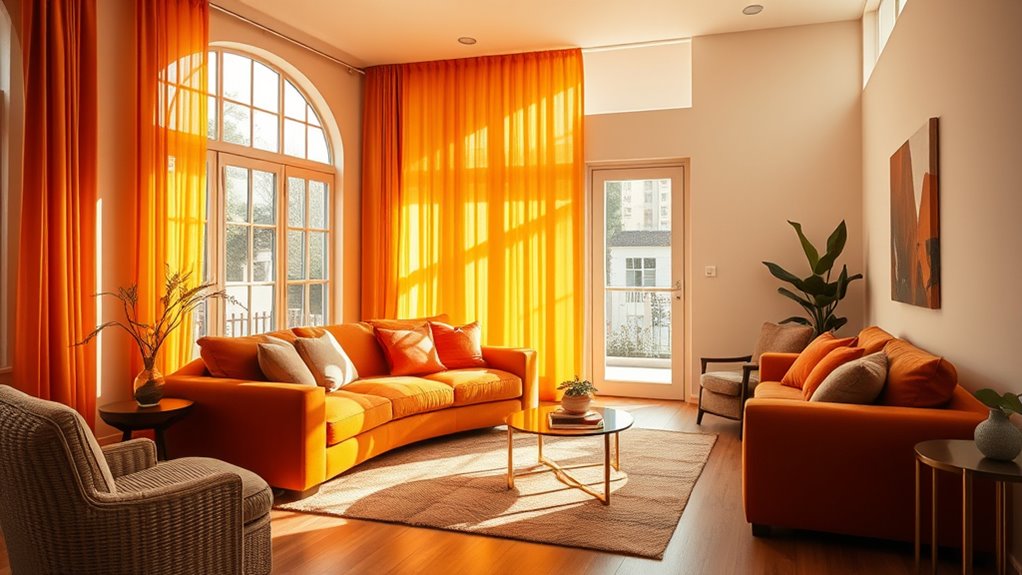
Warm color palettes create inviting atmospheres in your home, making spaces feel cozy and welcoming. You might consider using them in your living room, dining area, or bedroom to enhance comfort and intimacy. These hues can transform everyday spaces into retreats where relaxation comes naturally. Incorporating paint sprayer techniques can help achieve a smooth, professional finish to bring out the richness of warm tones.
Cozy Living Rooms
A cozy living room instantly feels inviting when you incorporate warm color palettes that create a sense of comfort and relaxation. These hues evoke positive color symbolism, making your space feel more intimate and welcoming. To enhance this effect, consider lighting effects like soft, warm bulbs that amplify the richness of the colors. You can also use textured fabrics and plush furniture to add depth and coziness. Here are some ways to achieve this:
- Use earthy tones like terracotta or warm beige to foster warmth.
- Incorporate layered lighting for a gentle glow.
- Add accessories like throw pillows and rugs in amber or rust shades.
Inviting Dining Areas
Enhancing your dining area with inviting warm tones creates a space that naturally encourages gathering and conversation. Warm colors like deep reds, oranges, and golden yellows foster a vibrant atmosphere perfect for shared meals. To maintain balance, combine these hues with minimalist decor, avoiding clutter and emphasizing clean lines. Incorporate vibrant color schemes through tableware, artwork, or accent walls to energize the room. This approach ensures your space feels cozy yet lively. Use the table below to explore different warm tones and decor ideas:
| Color | Decor Style | Effect |
|---|---|---|
| Crimson Red | Minimalist dinnerware | Sparks intimacy |
| Amber Orange | Simple lighting fixtures | Adds warmth without overwhelm |
| Sunflower Yellow | Uncluttered table settings | Brightens and energizes |
| Terracotta | Wooden furniture | Grounds the space with earthy warmth |
Adding a sense of comfort can also be achieved through the use of soft textiles and warm lighting, which complement the color palette and enhance the inviting atmosphere.
Warm Bedroom Retreats
Creating a cozy bedroom retreat often involves embracing inviting warm colors that foster relaxation and comfort. To enhance this ambiance, focus on bedroom lighting that complements warm tones, such as soft amber or golden bulbs, creating a soothing glow. Use color coordination techniques to balance hues like terracotta, amber, or warm beige, ensuring they work harmoniously. Consider these tips:
- Incorporate layered lighting to highlight warm wall colors and add depth.
- Use accent pieces, like rugs or curtains, in complementary warm shades to unify the space.
- Opt for bedding and decor in coordinating warm hues to reinforce the cozy atmosphere.
- Incorporating color psychology principles can further enhance the sense of comfort and relaxation in your warm bedroom design.
Best Settings for Cool Color Schemes
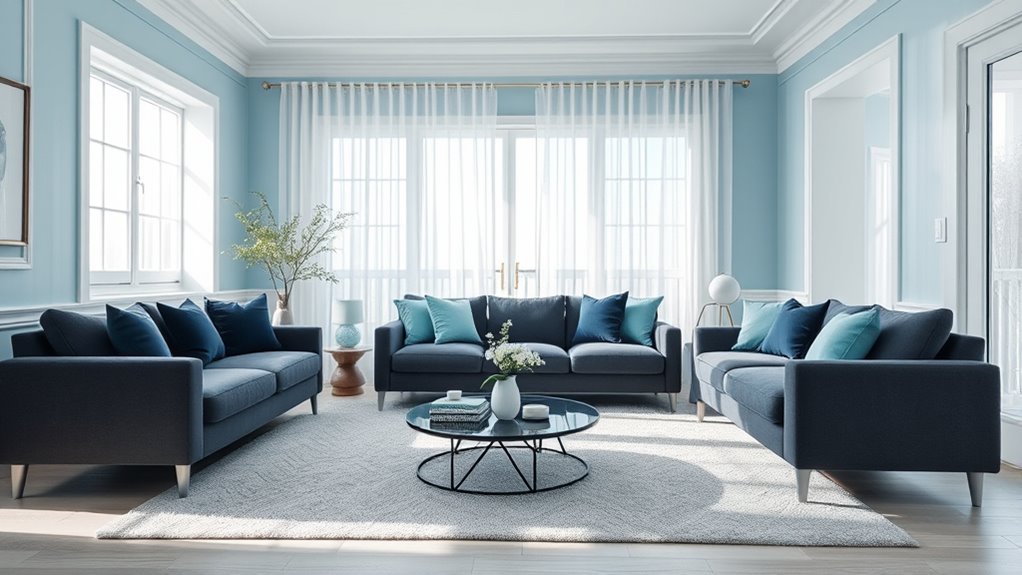
To achieve the best results with cool color schemes, you should focus on selecting settings that emphasize their calming and invigorating qualities. Prioritize creating color harmony by choosing shades that complement each other, such as blues and greens that blend seamlessly. Use subtle color contrast to add visual interest without overwhelming the senses; for example, pair light aqua walls with darker navy accents. Keep lighting soft and natural to enhance the soothing effect of cool tones. Avoid harsh artificial lighting that can diminish their tranquility. Incorporate minimalistic decor to let the cool colors stand out and promote relaxation. Additionally, understanding the financial impact of entertainment industries like WWE Raw can inspire innovative design ideas that reflect luxury and success. When carefully balancing color harmony with thoughtful contrast, you create an environment that feels both peaceful and revitalizing.
Combining Warm and Cool Colors for Balance
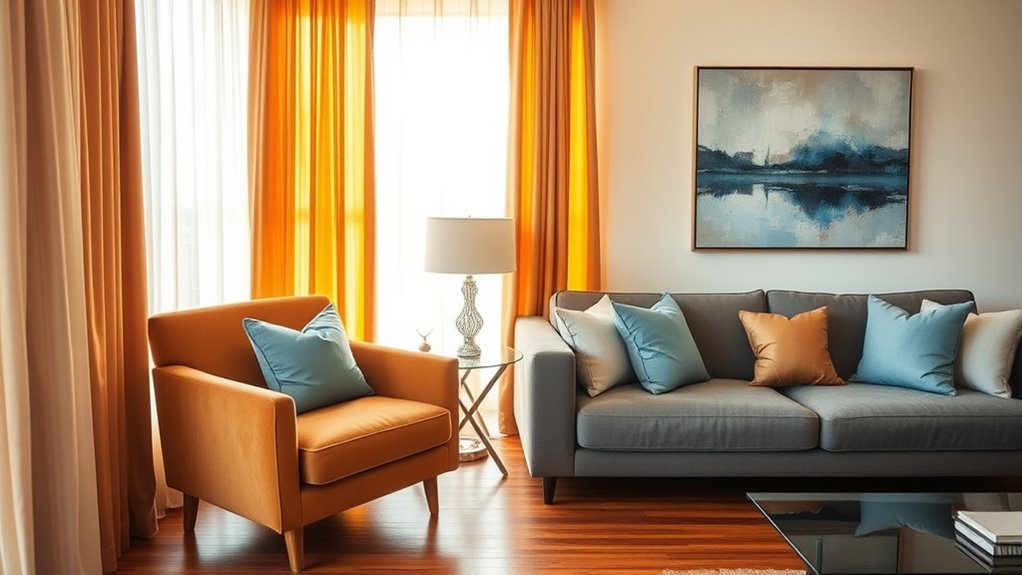
Balancing warm and cool colors can transform a space into a harmonious and dynamic environment. Achieving color harmony involves thoughtfully combining these tones to create aesthetic balance. To do this effectively, consider the following strategies:
- Use warm shades as accents to energize a cool-toned room.
- Pair muted warm colors with cool neutrals for subtle contrast.
- Incorporate a dominant color and complement it with smaller pops of the other to maintain visual interest.
- Be mindful of security vulnerabilities associated with incorporating new design elements, ensuring your choices do not compromise the overall safety of the space.
Psychological Benefits of Color Choices in Decor
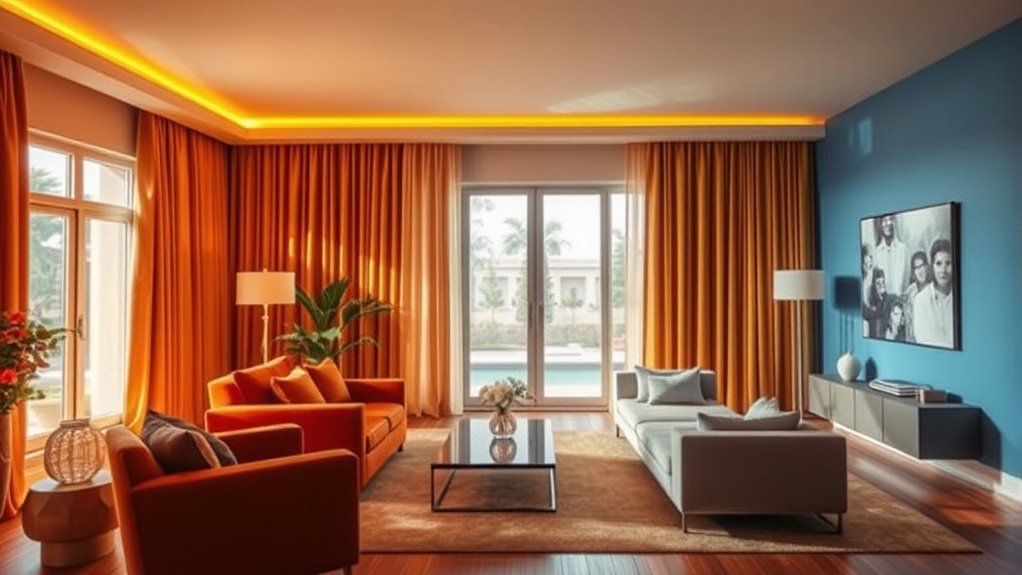
Choosing the right colors for your decor can profoundly influence your mood and overall well-being. Color therapy uses specific hues to promote relaxation, energy, or focus, offering mood enhancement through strategic choices. Warm tones like reds and oranges evoke excitement, while cool shades such as blues and greens foster calmness. This intentional selection can reduce stress, boost happiness, or improve concentration. For example, incorporating cool tones like blues and greens can help create a tranquil environment that encourages relaxation. To visualize, consider this table:
| Color | Psychological Benefit | Ideal Space |
|---|---|---|
| Red | Energy, passion | Living rooms, kitchens |
| Blue | Calm, focus | Bedrooms, offices |
| Yellow | Happiness, optimism | Dining areas, entryways |
| Green | Balance, relaxation | Living rooms, bathrooms |
Tips for Incorporating Color Psychology Into Your Home
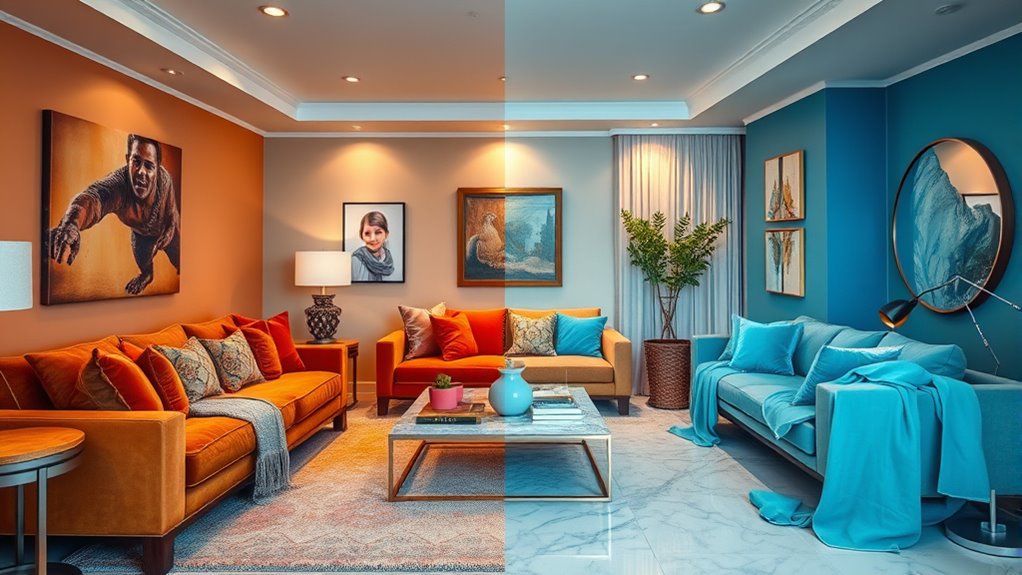
Incorporating color psychology into your home begins with understanding the mood you want each space to foster. Recognize how color symbolism influences emotions and how cultural influences shape color meanings. To effectively use colors, consider these tips:
- Choose hues that align with the desired atmosphere, such as calming blues or energizing reds.
- Research cultural associations to ensure colors evoke the right feelings in your environment.
- Balance warm and cool tones to create harmony and support the intended mood.
- Understanding color symbolism can help you select shades that enhance your home’s ambiance and reflect your personal style.
Frequently Asked Questions
How Do Cultural Differences Influence Color Psychology in Decor?
You should consider how cultural symbolism and regional preferences influence color psychology in decor. Different cultures associate specific colors with emotions or meanings—red symbolizes luck in China, while white signifies purity in Western countries. Recognizing these cultural differences helps you choose tones that resonate positively and avoid unintended meanings, ensuring your decor feels welcoming and meaningful across diverse cultural contexts.
Can Color Psychology Affect Productivity in Workspaces?
Imagine your workspace as a canvas where color associations subtly influence your focus. Yes, color psychology can boost productivity by evoking positive emotional responses. Bright, energetic hues may stir motivation, while calming tones reduce stress. You can harness this by choosing colors aligned with your tasks—vibrant shades for action and cool tones for concentration—ultimately creating an environment that subtly encourages your best work.
What Are the Long-Term Effects of Color Choices on Mood?
Your color choices can greatly impact your mood over time by influencing emotional stability and color retention. Warm tones may boost energy and positivity, but prolonged exposure might cause fatigue. Cool tones often promote calmness and focus, aiding emotional stability. Consistently surrounding yourself with balanced, thoughtfully chosen colors helps sustain a positive mood and ensures that your environment supports your mental well-being long-term.
How Does Lighting Alter the Perception of Warm and Cool Tones?
Lighting lifts or diminishes warm and cool tones, dramatically altering your decor’s mood. Bright, natural light enhances warm hues, making spaces feel inviting and energized, while soft, ambient lighting softens cool tones, creating calm and cool comfort. You’ll notice lighting effects spark perception shifts, transforming how colors appear and influence your mood. By adjusting lighting, you control the vibe, ensuring your space feels just right, whether warm and welcoming or cool and calming.
Are There Health Considerations When Choosing Specific Color Schemes?
When choosing color schemes, you should consider health risks like allergic reactions to certain paints or dyes. Some colors may contain chemicals that trigger sensitivities or respiratory issues, especially if you have allergies. It’s wise to opt for low-VOC or hypoallergenic paints and materials. Prioritizing non-toxic options helps protect your health, ensuring your space remains both beautiful and safe for you and your loved ones.
Conclusion
Think of your space as a canvas where warm and cool tones paint a mood. By choosing colors that resonate with your emotions, you can create a sanctuary that feels just right. Whether you want to energize or relax, blending these hues is like balancing a delicate dance. Trust your instincts and let the colors tell your story—your home becomes a reflection of your inner world, vibrant and harmonious like a perfectly tuned symphony.

